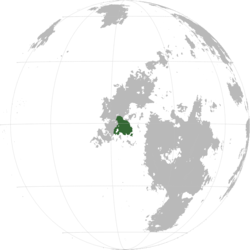Difference between revisions of "Archive:Mujansa"
m |
m |
||
| Line 1: | Line 1: | ||
{{Infobox country | {{Infobox country | ||
|conventional_long_name = | |conventional_long_name =Union of Mujansa <!--Formal or official full name of the country in English--> | ||
|native_name =''Mu Ṛan'' | |native_name =''Dintēm Mu Ṛan'' (Jaiso)<br> | ||
''Tanthemsa Mucansasā'' (Anchashi) <!--Country's name (usually full name) in its native language, hence in italics (double quotemarks)--> | |||
|common_name =Mujansa <!--Common name in English (used for wikilinks and to produce a default iso3166 code)--> | |common_name =Mujansa <!--Common name in English (used for wikilinks and to produce a default iso3166 code)--> | ||
|image_flag = MujansaFlag.jpg <!--e.g. Flag of country.svg--> | |image_flag = MujansaFlag.jpg <!--e.g. Flag of country.svg--> | ||
| Line 26: | Line 27: | ||
|largest_settlement_type = <!--Type of settlement if largest settlement not a city--> | |largest_settlement_type = <!--Type of settlement if largest settlement not a city--> | ||
|largest_settlement = <!--Name of largest settlement--> | |largest_settlement = <!--Name of largest settlement--> | ||
|official_languages = Jaiso <!--Languages recognised in legislation, constitution, etc--> | |official_languages = Jaiso<br>Anchashi <!--Languages recognised in legislation, constitution, etc--> | ||
|national_languages = | |national_languages = <!--Country/territory-wide languages recognised but not necessarily in country/territory-wide law, etc--> | ||
|regional_languages = Yurija-Yakuna languages<br>Mlangic languages<!--Languages recognised or associated with particular regions within the country/territory--> | |regional_languages = Yurija-Yakuna languages<br>Mlangic languages<!--Languages recognised or associated with particular regions within the country/territory--> | ||
|languages_type = <!--Use to specify a further type of language, if not official, national or regional--> | |languages_type = <!--Use to specify a further type of language, if not official, national or regional--> | ||
| Line 117: | Line 118: | ||
}} | }} | ||
'''Mujansa''' (<small>Jaitho:</small> ''Mu Ṛan'' [[Language#Phonology|mu˧ ɻan˧]]), officially the '''Republic of Mujansa''', is a country located in Nagu, bordered by [[Cananganam]] and [[Ukutunajas]] in the west. <!-- add the country's geographic location, name its neighbours (if any) --> <!--Briefly present the country in terms of history, language, politics, something the country is well-known for. --> | '''Mujansa''' (<small>Jaitho:</small> ''Dintēm Mu Ṛan'' [[Language#Phonology|din˧tʰem˥ mu˧ ɻan˧]]), officially the '''Republic of Mujansa''', is a country located in Nagu, bordered by [[Cananganam]] and [[Ukutunajas]] in the west. <!-- add the country's geographic location, name its neighbours (if any) --> <!--Briefly present the country in terms of history, language, politics, something the country is well-known for. --> | ||
==Etymology== | ==Etymology== | ||
| Line 126: | Line 127: | ||
Proto-Gyai speakers migrated into the area around the 1st century CE. By X, there was a large amount of land ruled by local lords who swore allegiance to the emperor back in Rem Kam Bam. The rivers X and X were vital, as they were the main way of carrying goods, people and soldiers around the domains. | Proto-Gyai speakers migrated into the area around the 1st century CE. By X, there was a large amount of land ruled by local lords who swore allegiance to the emperor back in Rem Kam Bam. The rivers X and X were vital, as they were the main way of carrying goods, people and soldiers around the domains. | ||
<b>Canamic conquest</b> | <b>Canamic conquest</b> | ||
In year X, the Canamic empire launched a campaign headed by general | In year X, the Canamic empire launched a campaign headed by general Nagaajeekhaa Saẓeeṭṣee in response to increased raids and attacks by the native Dagyelics. He defeated emperor Jỹ Lú at the battle of Ṭin, then proceeded to travel around the empire, forcing nobles to capitulate. | ||
==Geography== | ==Geography== | ||
Revision as of 17:02, 9 May 2021
| Union of Mujansa Dintēm Mu Ṛan (Jaiso) Tanthemsa Mucansasā (Anchashi) |
||||
|---|---|---|---|---|
|
||||
Mujansa in Nagu
|
||||
| Capital and | Kỹháṛi | |||
| Official languages | Jaiso Anchashi |
|||
| Recognised regional languages | Yurija-Yakuna languages Mlangic languages |
|||
| Demonym | Mujansan | |||
| Government | Directorial Republic | |||
| Establishment | ||||
| - | Conquest by the Cananganamese Empire | 9 BCE | ||
| Area | ||||
| - | 611,855.72 km2 236,238.8142085 sq mi |
|||
| Population | ||||
| - | estimate | 51.395.880 | ||
| - | census | 50.170.00 | ||
| - | Density | 84/km2 217.6/sq mi |
||
Mujansa (Jaitho: Dintēm Mu Ṛan din˧tʰem˥ mu˧ ɻan˧), officially the Republic of Mujansa, is a country located in Nagu, bordered by Cananganam and Ukutunajas in the west.
Etymology
The name "Mujansa" comes from proto-Gyai *mu˩˧ du˩ jan˩ sa˩˧, with the meaning “Land of the many islands”, loaned into Canana as Mūduyansa, later reloaded into Jaitho as Mu Ran
History
Pre-Canamic era Proto-Gyai speakers migrated into the area around the 1st century CE. By X, there was a large amount of land ruled by local lords who swore allegiance to the emperor back in Rem Kam Bam. The rivers X and X were vital, as they were the main way of carrying goods, people and soldiers around the domains. Canamic conquest In year X, the Canamic empire launched a campaign headed by general Nagaajeekhaa Saẓeeṭṣee in response to increased raids and attacks by the native Dagyelics. He defeated emperor Jỹ Lú at the battle of Ṭin, then proceeded to travel around the empire, forcing nobles to capitulate.

